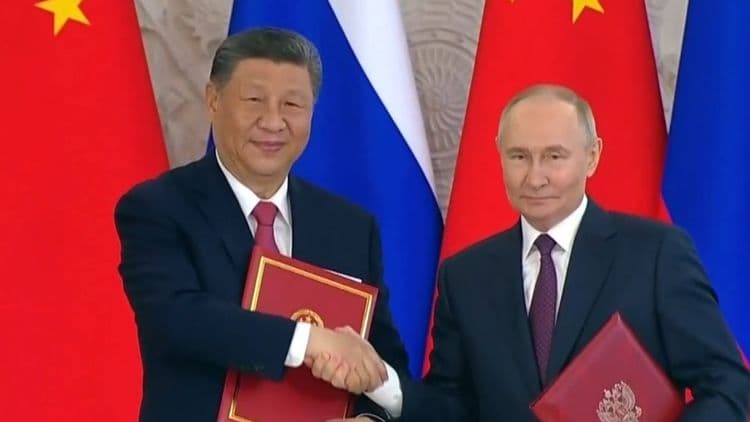
Along with the diplomatic power play of uniting three authoritarian leaders, China's massive military parade was a major flex of weaponry.
As soldiers in pristine and pressed uniforms marched in lockstep down Chang'an Avenue into Tiananmen Square yesterday, the People's Liberation Army rolled out new nukes, other missiles, lasers, drones and even"robot wolves".
As Beijing looks to extend its influence in an uncertain world, one retired Australian army major general says the days of China relying on foreign powers for weaponry are"long gone". Here are some of the weapons on display:


Nukes
The parade featured several missiles capable of delivering nuclear warheads from air, sea and land in what Xinhua News Agency called a"triad of strategic nuclear forces".
International Institute for Strategic Studies Chinese security and defence policy senior fellow Meia Nouwens said the display of the three systems together, reportedly for the first time, was a notable message of deterrence to the US and other allies.
The missiles were the air-based long-range missile Jinglei-1, the submarine-launched intercontinental missile Julang-3 and land-based intercontinental missiles Dongfeng-61 (DF-61) and Dongfeng-31.
The DF-61 can be fired from a mobile launching platform and while there aren't many details on its capabilities, its predecessor can carry several warheads more than 12,000 kilometres, enough to reach Washington DC or any part of Australia or New Zealand from Beijing.
The newest variant of the silo-based DF-5, the DF-5C, can go even further – 20,000 kilometres, essentially far enough to reach any point on earth.
There were also hypersonic anti-ship missiles from the Yingji project that China previously tested against mockups of US aircraft carriers.

Other missiles
Amongst the range of other new missiles on show, there were several designed to attack shifts, a clear threat to the US's naval power in the Asia-Pacific.
The YJ-series anti-ship missiles are all capable of operating at long ranges and hypersonic, making them difficult to intercept, and several others are meant to intercept incoming anti-ship missiles.
"These are capabilities that are increasingly meant to signal to the United States they should think twice about entering into a conflict, if there ever is one, in support of Taiwan," Nouwens said.

Drones
Some of the advanced drone tech, including a small surface drone ship, on display appeared to be new but the event's official commentators didn't identify most of it.
But the pilotless attack and reconnaissance weapons weren't limited to the sky. The PLA also showed off submarine drones, the older-model HSU001 and much larger AJX002.
China's official Xinhua News Agency called them"cutting-edge surprise weapons for naval combat" designed for "covert deployment and blockade, autonomous detection and identification, and swarm-networked attacks".

Lasers and 'robot wolves'
With drones gaining increasing importance, there's also an arms race for systems to combat them.
China has been developing lasers to do just that and showed off a missile gun, high-energy laser weapons and high-power microwave weapons, which state media called an anti-drone"triad".
They might not have been the most deadly of the weapons on show but China's"robot wolves" were enough to inspire fear in many.
The weaponised canine machines were seen riding on the back of militarised vehicles during the parade.
China last year showed off a robot dog with an automatic rifle mounted on its back during exercises in Cambodia.
Chinese state media outletGlobal Times said the"wolf" model, which can tote rifles and climb ladders, was shown to the public for the first time in human-drone exercises in July.

Mick Ryan, a retired Australian army major general and analyst at the Lowy Institute, said the days where China was reliant on Russia or other foreign systems were"long gone".
"This level of indigenous capacity infers high levels of sustainability in any future conflict," hewrote on his Substack.
Still, he cautioned,"newer does not always mean better".
"While most Western military equipment has been tested in Iraq, Ukraine and elsewhere, none of China's new kit has," he said.
Chinese leader Xi Jinping, speaking before themilitary parade to mark the 80th anniversary of the end of World War II, said humanity must choose between peace and war and between dialogue and confrontation.

Xi's projection of power did not go unnoticed, provoking a response from US President Donald Trump on social media.
"Please give my warmest regards to Vladimir Putin, and Kim Jong Un, as you conspire against The United States of America," Trump said, on Truth Social.

